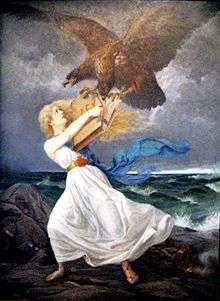Russification of Finland

The policy of Russification of Finland (1899–1905 and 1908–1917, called sortokaudet/sortovuodet (times/years of oppression) in Finnish and förtrycksperioderna in Swedish) was a governmental policy of the Russian Empire aimed at limiting the special status of the Grand Duchy of Finland and possibly the termination of its political autonomy and cultural uniqueness. It was a part of a larger policy of Russification pursued by late 19th–early 20th century Russian governments which tried to abolish cultural and administrative autonomy of non-Russian minorities within the empire. The two Russification campaigns evoked widespread Finnish resistance, starting with petitions and escalating to strikes, passive resistance (including draft resistance) and eventually active resistance. Finnish opposition to Russification was one of the main factors that ultimately led to Finland's declaration of independence in 1917.
Under Tsarist Russia
Russia attacked Sweden in 1808, in what became later known as the "War of Finland". In 1809 the lost territory of Sweden became the Grand Duchy of Finland in the Russian Empire.[1] In 1809 the Finnish Diet recognized Tsar Alexander I as Grand Duke. For his part, Alexander confirmed the rights of the Finns, in particular, promising freedom to pursue their customs and religion and to maintain their identity:
- "Providence having placed us in possession of the Grand Duchy of Finland, we have desired by the present act to confirm and ratify the religion and the fundamental laws of the land, as well as the privileges and rights which each class in the said Grand Duchy in particular, and all the inhabitants in general, be their position high or low, have hitherto enjoyed according to the constitution. We promise to maintain all these benefits and laws firm and unshaken in their full force."[2]
First wave of Russification
This promise was maintained; indeed, Alexander II amplified the powers of the Finnish diet in 1869. Having enjoyed prosperity and control over their own affairs, and having remained loyal subjects for nearly a century,[2] the manifesto which Nicholas II issued on 15 February 1899 was cause for Finnish despair.[2] The manifesto was forced through the Finnish senate by the deciding vote of the senate president, an appointee of the tsar—and after the governor-general of Finland, Nikolay Bobrikov, had threatened a military invasion and siege.[2] While ostensibly affirming the Finns' rights in purely local matters, the manifesto asserted the authority of the state in any and all matters which could be considered to "come within the scope of the general legislation of the empire."[2]
Russification policies enacted included:
- The above-mentioned February Manifesto of 1899, the decree by Nicholas II which asserted the imperial government's right to rule Finland without the consent of local legislative bodies, under which:[2]
- Russian currency and stamps were the only allowed;
- Russian was made official language of administration (in 1900, there were an estimated 8,000 Russians in all of Finland, of a population of 2,700,000)—the Finns saw this as placing the Russian minority in charge;
- the Orthodox Russian Church was the church of state; including, for example, criminalizing the act of subjecting a follower of the Orthodox church to a Lutheran church service;
- the press was subject to Russian censorship;
- the Finnish army was made subject to Russian rules of military service.
- The Language Manifesto of 1900, the decree by Emperor Nicholas II which made Russian the language of administration of Finland.
- The conscription law, signed by Nicholas II in July 1901 incorporating the Finnish army into the imperial army.
From April 1903 until the Russian Revolution of 1905, the governor-general was granted dictatorial powers. In June 1904 Eugen Schauman assassinated Bobrikov, the incumbent. The imperial government responded with a purge of opponents of Russification within the Finnish administration and more stringent censorship. However the resistance campaign also had some successes, notably a de facto reversal of the new conscription law.
The Russification campaign was suspended and partially reversed in 1905–07 during a period of civil unrest throughout the Russian empire following Russian defeats in the Russo-Japanese War.
Second wave of Russification
The program was reintroduced in 1908 on, costing Finland much of its autonomy and again causing further Finnish resistance, including the Jäger movement. Many measures were again suspended in 1914–17 during the First World War, but secret government documents published in the Finnish press in November 1914 suggested that the imperial government still harbored plans for the complete Russification of Finland.
Japanese involvement
During the Russo–Japanese War with the financial aid from Japan the rebels bought a shipment of thousands of rifles with the aim of creating an uprising and forming an independent state. However, the ship was wrecked off the coast of Finland and the plan fell apart. During the First World War when Russia and Japan were allies fighting against Germany, the Japanese handed to the Russian government a list of leading men in the freedom movement (now in World War I working with Imperial Germany).
German involvement
During the First World War the Jäger movement received German support.
See also
References
- ↑ Grand Duchy of Finland
- 1 2 3 4 5 6 Johnson, A.; Bickford, C., Hudson, W., Dole, N. Cyclopedic Review of Current History. Volume 9. Garretson, Cox & Co. 1899 page 198 and following
Further reading
- Sergeevskii, N. D. Finland : the question of autonomy and fundamental laws (1911)
- Alenius, Kari. "Russification in Estonia and Finland Before 1917," Faravid, 2004, Vol. 28, pp 181–194
- Huxley, Steven. Constitutionalist insurgency in Finland: Finnish "passive resistance" against Russification as a case of nonmilitary struggle in the European resistance tradition (1990)
- Polvinen, Tuomo. Imperial Borderland: Bobrikov and the Attempted Russification of Finland, 1898–1904 (1995)
- Thaden, Edward C. Russification in the Baltic Provinces and Finland (1981).
External links
- The Era of Russification
- "The Gracious Manifesto of the Imperial Majesty", text of the February Manifesto of 1899 (in English)
- Nicholas's Decree Limiting Finnish Autonomy, March 20, 1903 (in English)
